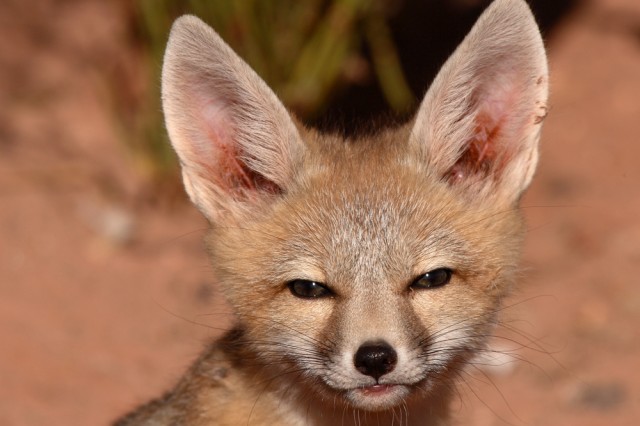San Joaquin Kit Fox
Status
San Joaquin Kit Fox (Vulpes macrotis mutica), is Federally-listed as Endangered under the Federal Endangered Species Act (March 11, 1967) and State-listed as Threatened under the California Endangered Species Act (June 27, 1971). It is an uncommon to rare, permanent resident of arid regions of the southern portion of California. Historically, the range of San Joaquin kit fox extended from southern Kern County north to Contra Costa County and Stanislaus County. Currently the kit fox population is fragmented throughout the state, mainly due to the loss and degradation of habitat from industrial and agricultural practices and urban development.
Description
The San Joaquin kit fox is the smallest fox in North America, with an average body length of 20 inches and weight of about 5 pounds. It is a member of the Canidae family which includes dogs, foxes, and wolves. San Joaquin kit foxes are light in build, with long legs and large ears. Their coat ranges from tan to buffy gray in the summer to silvery gray in the winter. Their belly is generally whitish in color and their tail is black-tipped.
Habitat Requirements
San Joaquin kit fox occurs in dry annual grasslands or grassy open stages of vegetation with scattered brush and shrubs. They prefer open, level areas with loose-textured soils which they use for denning. Dens are used for temperature regulation, shelter from adverse weather and protection from predators. Kit foxes either dig their own dens, use those constructed by other animals, or use human-made structures such as culverts or abandoned pipes. In general, San Joaquin kit fox burrows/dens are taller than wide and often have vertical scratch marks on the ceiling of the entrance. Burrow entrances must be narrow enough (approximately 8 inches or less) to exclude coyotes and other predators. In September or October, adult females begin to clean and enlarge their natal dens and mating then occurs between December and March. Litters of two to six pups are born in February and March and pups emerge from the den approximately one month later. Pups are generally weaned at about 4 to 5 months.
The diet of San Joaquin kit fox varies geographically, seasonally and annually, depending on the abundance of prey. In the southern part of their range, much of the diet consists of kangaroo rats, pocket mice, white-footed mice and other nocturnal rodents. In the northern portion of the range, kit foxes most often prey on California ground squirrels. San Joaquin kit fox is also known to prey on black-tailed hares, desert cottontails, ground-nesting birds, and insects. They hunt by searching, meandering, and circling clumps of brush, and wandering back and forth between clumps of vegetation. They stealthily approach larger prey and pounce on smaller prey. Natural predators of San Joaquin kit fox include coyotes, large hawks and owls, eagle and bobcats.
Local Occurrence
The San Joaquin kit fox occurs on several WHF preserves in the San Joaquin Valley, including Deadman Creek, Great Valley at Flynn Ranch, Haera Ranch, and Sand Creek.

 (916) 434-2759
(916) 434-2759



